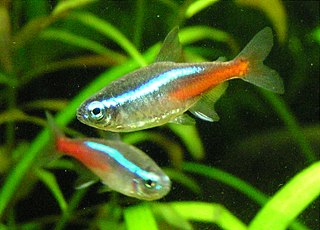
Paracheirodon is a genus of freshwater fish in the family Characidae of the order Characiformes. The type species is P. innesi, the well-known neon tetra, and the Paracheirodon species are among the fishes known as tetras. All species of this genus are native to the Neotropical realm, occurring in the Orinoco and Amazon Basins in northern South America.

Cynodontidae, also known as dogtooth characins or vampire tetras, are a family of predatory, characiform freshwater fishes from South America. This group is not very diverse, and includes only five genera and 14 species. Most of what is known about this family is from the members of the subfamily Cynodontinae, which includes the largest species of this family, up to 117 cm (3.84 ft). The members of subfamily Roestinae only reach up to 20 cm (7.9 in). and are less known.

The Prochilodontidae, or flannel-mouthed characins, are a small family of freshwater fishes found primarily in the northern half of South America, south to Paraguay and northern Argentina. This family is closely related to the Curimatidae, and in the past they were included in Characidae.

Corydoras atropersonatus is a tropical freshwater fish belonging to the subfamily Corydoradinae of the family Callichthyidae. It originates in inland waters in South America, and is found in the upper Amazon River basin in Ecuador and Peru.

The fahaka pufferfish, also known as the Nile puffer, globe fish, lineatus puffer, is a tropical freshwater pufferfish found in the upper Nile, Chad, Senegal, Gambia, Geba, Volta and Turkana basins in West, Northeast and East Africa.

Rhamphochromis is a genus of East African haplochromine cichlids endemic to the Lake Malawi basin, also including Lake Malombe, Lake Chilingali, Chia Lagoon and upper Shire River. They mainly occur in offshore open waters, but a few species also near the coast. They are piscivores that typically feed on lake sardines and small utaka cichlids.

Pseudopimelodus is a genus of catfishes of the family Pseudopimelodidae.

Platysilurus is a genus of long-whiskered catfishes native to South America.
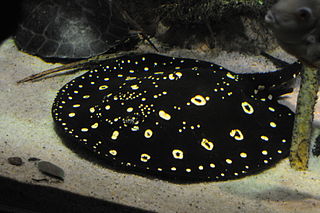
The bigtooth river stingray or Tocantins River ray is a species of freshwater fish in the family Potamotrygonidae. It is endemic to the lower Tocantins basin and Araguaia basin in Brazil, and prefers muddy bottoms. It is sometimes kept in aquaria. This stingray is generally common and its population increased after the Tucuruí Dam was completed, unlike many other species in its range.

The banded lampeye is a species of poeciliid that is native to Africa, ranging from Senegal to Angola. It is mainly found in coastal brackish habitats such as river mouths, lagoons and mangrove swamps. It reaches up to 7 cm (2.8 in) in total length.
Sauvagella robusta is a small species of fish in the family Clupeidae. It is endemic to the Amboaboa and Mangarahara River Basins in northern Madagascar. This relatively slender fish reaches a length of 6.8 cm (2.7 in), and is overall pale yellowish with silvery on the lower parts. Its current conservation status is unclear, but the cichlid Ptychochromis insolitus, which is highly threatened from habitat loss, is native to the same region. Sauvagella robusta is known to survive at least in Lake Tseny.

Bryconops is a genus of freshwater fish in the family Iguanodectidae from South America. It consists of small fish, all under half-a-foot long, with slender bodies and silvery scales, though there is some mild color variation. Several species can be identified by way of a humeral patch, and others have a reddish ocellus, or eyespot, on one or both lobes of the dorsal fin.
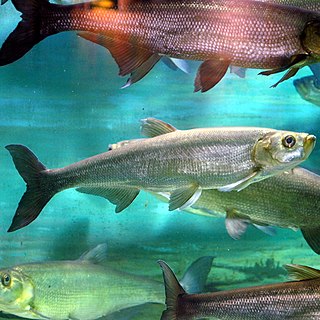
The predatory carp, also known as the redfin culter or skygazer, is a species of ray-finned fish in the genus Chanodichthys. This East Asian freshwater cyprinid ranges from the Amur River south to Taiwan and the Red River, as well as Lake Buir in Mongolia. It reaches 102 cm in length and 9 kg (20 lb) in weight.
Henry's mormyrid is a species of freshwater elephantfish in the family Mormyridae and the only member of its genus. It occurs in coastal river basins in West Africa, ranging as far southeast as the Kouilou-Niari River in Middle Africa. It reaches a length of about 29 cm (11 in).

Prochilodus is a genus of freshwater fish from the family Prochilodontidae. This family include two other genera, Ichthyoelephas and Semaprochilodus, which have been included in Prochilodus instead. The greatest species richness of Prochilodus is in river basins in eastern, southeastern and southern Brazil, but there are also species in the river basins of the Amazon, Guianas, Colombia, Venezuela, Paraguay and northeastern Argentina. The largest species in the genus reach about 80 centimetres (2.6 ft) in length, but most species barely reach half that size.
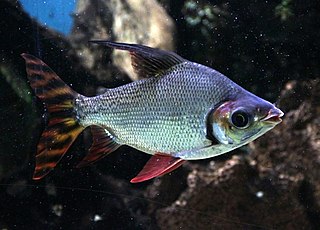
Semaprochilodus is a genus of South American freshwater fish in the family Prochilodontidae. They have sometimes been included in the genus Prochilodus instead. Of the six species, three are from the Amazon Basin, two from the Orinoco Basin and a single from the Maroni Basin. Depending on the exact species, they reach a maximum length of 27–54 centimetres (11–21 in).
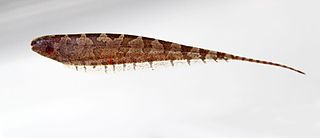
Steatogenys elegans, the barred knifefish, is a species of Hypopomidae found in tropical South America. It is the type species of its genus. It is an electric fish found in a wide range of freshwater habitats in the Amazon, Orinoco and Essequibo river basins. It reaches almost 30 cm (1 ft) in total length.
Bryconops humeralis is a small freshwater fish distributed across northern South America. The name "humeralis" means "relating to the shoulder", in reference to the distinct humeral patches that the fish sports. It is slightly longer than average in terms of the genus Bryconops, though still firmly within the standard range, and is slightly more slender than is usual for its congeners.
Bryconops inpai is a small freshwater fish native to the rivers of South America. It only lives in two particular river systems - the Casiquiare and Negro - which means that its range is restricted to the northern half of the continent. It has indistinct humeral spots, and is bluish-silver in life, which is unusual for members of Bryconops; they are more often plain silver or greenish-silver.
Bryconops vibex is a small freshwater fish from the rivers of Venezuela, known solely from the Rio Cataniapo. The body is slender, though with an element of sturdiness, and it has one humeral spot by each pectoral fin. It bears visual similarities to several congeners, but can be differentiated by way of many factors.














